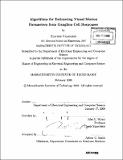Algorithms for estimating visual motion parameters from ganglion cell responses
Author(s)
Valavanis, Stavros
DownloadFull printable version (27.08Mb)
Other Contributors
Massachusetts Institute of Technology. Dept. of Electrical Engineering and Computer Science.
Advisor
John L. Wyatt.
Terms of use
Metadata
Show full item recordAbstract
This thesis is intended to present a specific sub-problem of a larger one we call the "Inverse Problem". We wish to estimate the velocity (speed and direction) of an edge of light which is moving on the photoreceptor layer of a rabbit retinal patch. We make these estimates based solely on the electrical responses measured from the retinal ganglion cells (RGCs). To this end, we develop five novel algorithms. The first four of these are least squares based and the fifth one employs a maximum likelihood approach. We present a sensitivity analysis on the four least squares algorithms. We also develop a novel method for reweighing these least squares algorithms so as to minimize a weighted sum of the variances of our estimates. The fifth algorithm is significantly more complex than the first four as it involves creating cell models through "training"; moreover, it uses the entirety of each cell's response whereas the least squares algorithms use only first order statistics of each cell's response. We present and compare the results of the top performing least squares algorithm with the fifth algorithm on data recorded from a retinal patch. Through simulations, we explore the effects of using a small number of closely "clustered" cells on the performance of these two algorithms.
Description
Thesis (M. Eng.)--Massachusetts Institute of Technology, Dept. of Electrical Engineering and Computer Science, 2008. Includes bibliographical references (p. 170-171).
Date issued
2008Department
Massachusetts Institute of Technology. Department of Electrical Engineering and Computer SciencePublisher
Massachusetts Institute of Technology
Keywords
Electrical Engineering and Computer Science.